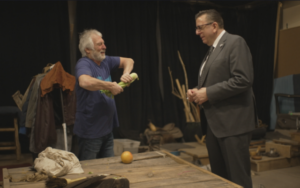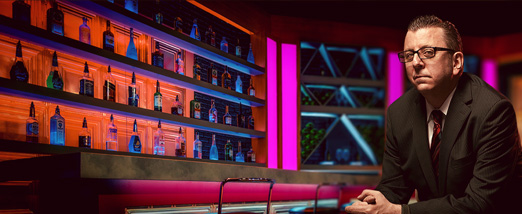W5: RICHARD REPORTS ON THE INVISIBLE ART OF FOLEY IN MOVIES!
 A story I did for “W5,” Canada’s most-watched current affairs and documentary program, on Foley master Andy Malcolm and his team at Footsteps Studio, aired on Sat. April 1 on CTV & CTV GO! “Everybody within the industry,” said recent Oscar winner Sarah Polley, who appears with me in the piece, “kind of worships him.”
A story I did for “W5,” Canada’s most-watched current affairs and documentary program, on Foley master Andy Malcolm and his team at Footsteps Studio, aired on Sat. April 1 on CTV & CTV GO! “Everybody within the industry,” said recent Oscar winner Sarah Polley, who appears with me in the piece, “kind of worships him.”
Watch Part One of the story HERE and part two HERE to learn how Andy creates the sounds you hear in movies.
A QUICK HISTORY OF FOLEY:
The “Star Wars” lightsaber is one of the most famous props in movie history, but would it have become as iconic without its high-tech hum? We’ll never know, because of one man, sound designer and Foley artist Ben Burtt.
On the set the lightsabers were silent. Cobbled together from thrift stores finds like Graflex camera parts, World War I rifle grenades and faucet knobs, the glowing weapons looked cool, unlike any other sword in movie history, but needed a sound to make it pop.
Ignoring the usual futuristic electronic sounds common to sci-fi movies, Burtt chose to mix “found sounds” to create a more natural sound. The former projectionist recorded the warm hum of projection equipment mixed with the buzz of a vintage television tube. The result was the now instantly recognizable hum of a lightsaber, a Foley effect added to the film in post-production.
Named after movie pioneer Jack Foley, Foley is the art of creating and performing sounds for movies and television shows. The one-time stuntman and silent film director began his sound career at the advent of the talkies, helping to bring movies like “The Jazz Singer” (1927), “Tarzan the Tiger” (1929) and “Dracula” (1931) alive with his techniques to create everyday sounds, like chewing, knocking on wood and footsteps.
For nearly thirty years Foley and his team labored, without credit, adding texture to Universal films with sound. When the studio restructured in the 1950s, Foley’s team, called his “disciples,” scattered, working all over Hollywood. In tribute, when they wrapped a scene they would say, “That’s a wrap. Let’s Foley it,” and the artform Foley created had an official name.
Many of the techniques Foley established are still in use today by Foley artists like Andy Malcolm, owner of Footsteps Post-Production Sound, located in Uxbridge, Ontario, an hour outside of Toronto.
“Watching Andy is like watching a magician,” says “Women Talking” director Sarah Polley.
For decades Malcolm and his team, now including apprentice Goro Koyama, supplied footsteps, page turns, gunshots and any other sound you can imagine in hundreds of movies, including “Women Talking,” “Dune,” “Bridesmaids” and “The 40-Year Old Virgin.”
Malcolm uses cornstarch to create the sound of footsteps in the snow, roast chickens to replicate punch sounds and raw pasta to create the sound of broken bones. Those are just a few of the secrets of his invisible art he revealed to W5 when we visited his “foley farm.”
“He’s a master,” says Polley, “and everybody within the industry kind of worships him. It’s like the energy of a four-year-old imagination, turbo, with adult genius.”
